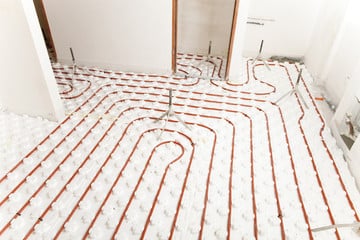Underfloor heating systems are experiencing renewed interest due to their thermal comfort and the fact that they free up wall space. Two main technologies are used: electric underfloor heating and hydraulic underfloor heating. This article presents a comparison of the different existing technologies, in order to facilitate your choice according to your needs.
Electric floor heating
Electric underfloor heating relies on the diffusion of heat via electric heating cables directly integrated into the structure of the floor. There are several types of electrical systems, including:
- resistance heating cables (or heating wires): Providing constant heat, they are often used to warm damp rooms such as bathrooms.
- the heating mat (or electric mat): Made up of a frame containing heating wires connected together, it is generally used to cover large surfaces quickly.
- plaster or heated screed: This is a specific material based on cement and heating cables which allows homogeneous distribution of heat over the entire surface of the floor.
Advantages of electric underfloor heating
The main advantage of this technology is its quick and fairly simple installation. In fact, the installation of electrical cables or frames can be carried out during renovation without requiring major work. In addition, there is no need for additional equipment such as pipes, hot water tanks or boilers.
For rooms requiring occasional heating, the electrical system also offers rapid rise in temperature. The costs associated with the purchase and installation of this equipment are generally lower than for hydraulic solutions.
Disadvantages of electric underfloor heating
In comparison with underfloor heating powered by water (hydraulic), we can emphasize sometimes lower efficiency and potentially higher energy consumption, although this depends on the choice of insulation and materials used.
Furthermore, in certain configurations, this type of heating can generate magnetic fields and therefore may not be recommended for people sensitive to these phenomena. It is also not recommended if you plan to install heavy objects on your floor such as a spa for example.
Hydraulic heating by heated floor
The hydraulic floor heating system works thanks to the circulation of hot water in a network of tubes integrated into the floor. The water is heated by a boiler, heat pump or other suitable device.
Advantages of hydraulic underfloor heating
This type of system has several advantages. First of all, it offers a better energy efficiency compared to electric heating, allowing the use of more energy-efficient equipment such as heat pumps or the possibility of connecting to renewable energies.
The thermal comfort provided is optimal with uniform distribution of the heat generated. As a result, it is ideal for large areas and avoids temperature loss towards the walls. THE heating level being gentle, the ground remains pleasant under the feet.
Finally, in terms of costs and maintenance, hydraulic underfloor heating proves to be less expensive in the long term and requires less maintenance than electric systems.
Disadvantages of hydraulic underfloor heating
The main disadvantages are linked to themore complex and expensive installation initial, as well as more important work in the event of renovation. Indeed, the tubes must be installed on a greater thickness of concrete slab and therefore require having sufficient space in the frame (in terms of ceiling height and surface area used).
Likewise, installing additional equipment such as a boiler or a heat pump can represent a significant investment. The start-up time of the hydraulic system is also longer, making it less suitable for rooms requiring rapid spot heating.
Conclusion: which system to choose?
The choice between electric underfloor heating and hydraulic underfloor heating depends above all on your needs, constraints and priorities in terms of thermal comfort, costs and installation. The electric solution will be preferred if you want a system that is easy to install, inexpensive and responsive for small areas or renovations. On the other hand, for a new house or for anyone wishing to benefit from better performance and comfort over a large area, hydraulic underfloor heating will emerge as a wise option. Also think about the compatibility of your systems with renewable energies and the regulations and limitations imposed by local legislation.







